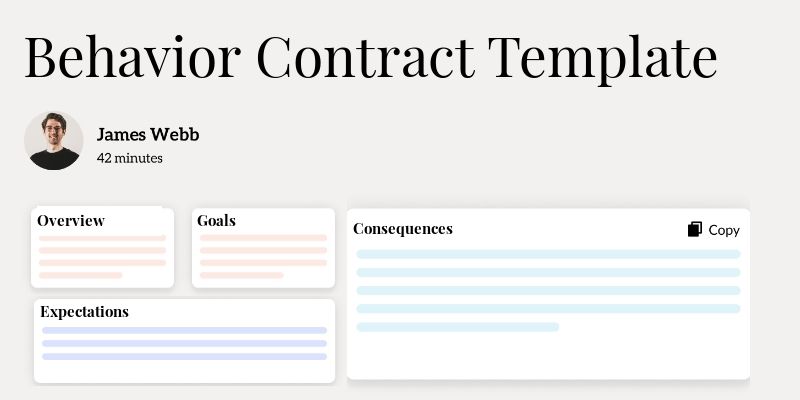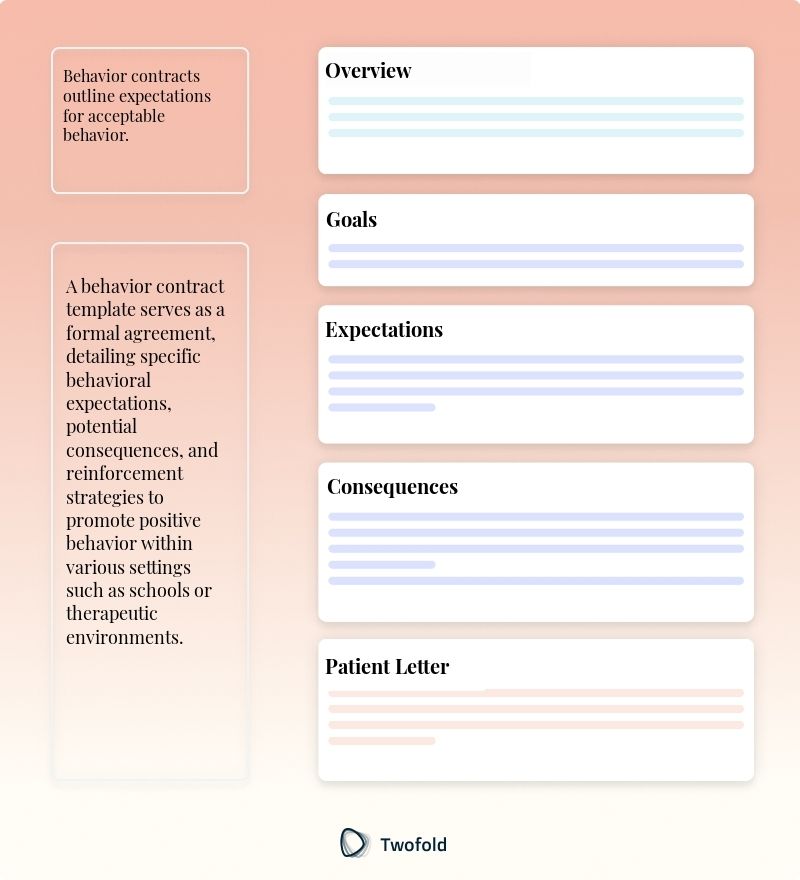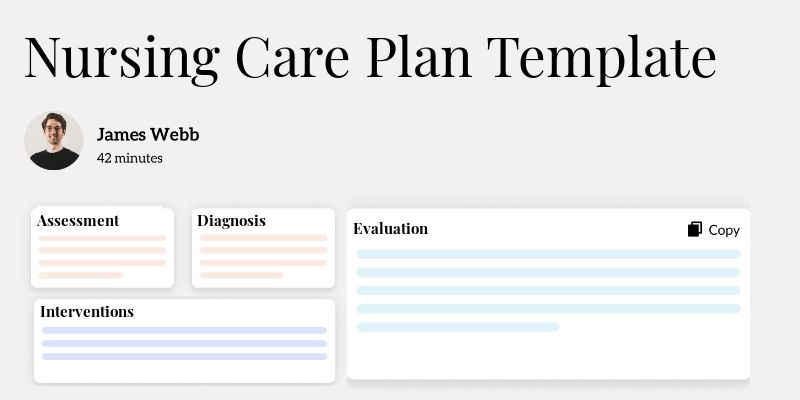
Behavior Contract Template
Imagine sitting with a challenging patient who has persisted in negative behaviors despite ongoing efforts. You've tried everything in your toolkit, yet nothing seems to stick. Enter the Behavior Contract Template—an often underutilized resource that can transform these situations by structuring agreements with little room for misinterpretation. In this post, we delve into how this template can serve as a game‑changer in managing patient behavior effectively.
What Is a Behavior Contract Template?
A Behavior Contract Template is a structured document used by healthcare professionals to set clearly defined expectations and consequences related to a patient's behavior. It serves as a formal agreement between a patient and a provider, aiming to encourage desired behaviors while addressing undesirable ones.
Typically utilized in therapeutic and behavioral interventions, this template lays out specified actions and commitments from both the patient and provider. Its use can significantly aid in establishing a clear plan to improve patient adherence and behavioral outcomes.
Key Components of a Behavior Contract Template
Here are the essential elements that make up an effective behavior contract:
- Patient Information: Name, date of birth, and any relevant case numbers
- Behavioral Expectations: Detailed descriptions of behaviors to be encouraged or discouraged
- Consequences: Clearly defined responses to adherence or non-adherence to the behavior expectations
- Signatures: All parties involved, including any witnesses, should sign the contract to validate it
- Review Date: A scheduled date for revisiting the contract to assess progress and make necessary amendments

How to Use a Behavior Contract Template: Step-by-Step Process
Step 1: Gather Information
Conduct an initial assessment to understand the behaviors that require modification. Evaluate the patient's history and current circumstances.
Step 2: Define Goals
Outline clear and achievable behavioral goals based on the assessment. Goals should be specific, measurable, attainable, relevant, and time‑bound (SMART).
Step 3: Draft the Contract
Utilize the template to write the contract, detailing the expectations, consequences, and responsibilities of all parties.
Step 4: Discuss with the Patient
Review the contract with the patient, explaining the terms and allowing for their input to ensure mutual understanding and agreement.
Step 5: Sign and Implement
All parties, including witnesses if necessary, should sign the contract. Begin implementing the contract in the patient's care plan.
Benefits of a Behavior Contract
Benefit | Description |
|---|---|
Enhances Accountability | Provides a clear framework that holds both patient and provider accountable for their commitments. |
Improves Communication | Establishes a straightforward means of discussing and reviewing behavior expectations and progress. |
Facilitates Record Keeping | Serves as a written record of the agreed terms, useful for future reference and audits. |
Encourages Positive Behavior | Reinforces desired actions through structured incentives and consequences. |
Stakeholders in Behavior Contract Templates
Multiple individuals are involved in developing and implementing a behavior contract:
- Patients - Example: A teenager in therapy agrees to attend school daily in exchange for weekend privileges.
- Healthcare Providers - Example: A therapist collaborates with a patient to address non-compliance with medication regimes.
- Family Members - Example: Parents sign a contract with their child, agreeing to monitor and support adherence to the contract’s terms.
- Educators - Example: A teacher helps create a behavior plan for a student with conduct issues, linking classroom behavior to privileges.
Example of a Behavior Contract PDF
To visualize a practical application, download an example Behavior Contract PDF online, detailing sections for fulfilling the intended use.
Real-World Use Cases: Practical Impact of the Behavior Contract Template
Behavior contracts often lead to meaningful change across a range of contexts:
- A young adult with substance abuse issues makes strides toward recovery by committing to sobriety milestones documented in a behavior contract.
- An elderly patient with recurrent falls agrees to physical therapy and low-impact exercises detailed in the contract to decrease fall risk.
- A child with defiant behavior improves interaction with peers by adhering to a contract that rewards positive social engagement.
Conclusion
The Behavior Contract Template offers a structured, effective approach to improving patient outcomes through clearly defined expectations and responsibilities. By involving all stakeholders, setting realistic goals, and maintaining consistent communication, these contracts can significantly enhance the management of patient behaviors. This ultimately leads to better adherence, improved communication, and a stronger therapeutic relationship.
Disclaimer: This article is for informational purposes only and does not constitute legal or medical advice. Always consult professional guidelines and regulatory bodies for specific compliance requirements.

Dr. Danni Steimberg
Dr. Danni Steimberg is a pediatrician at Schneider Children’s Medical Center with extensive experience in patient care, medical education, and healthcare innovation. He earned his MD from Semmelweis University and has worked at Kaplan Medical Center and Sheba Medical Center.
A behavior contract succeeds when expectations are crystal‑clear and accountability feels fair. The Commit‑and‑Consequence approach—polished through years of school‑based and outpatient compliance work—locks in motivation while keeping documentation audit‑proof.
- Define One Core Commitment: Phrase the target behavior in a single, measurable sentence (e.g., “Submit homework by 4 p.m. on school nights”) so progress is never ambiguous.
- Attach Proportional Consequences: Pair the commitment with both a realistic reward and fallback consequence, agreed to in advance—this balance boosts follow-through and withstands parental or payer scrutiny.
- Schedule Rapid Reviews: Build in brief check-ins (daily or weekly) and log outcomes right on the contract; frequent feedback reinforces change and provides airtight evidence of intervention efficacy.
Frequently Asked Questions
Reduce burnout,
improve patient care.
Join thousands of clinicians already using AI to become more efficient.

Nursing Care Plan Template
Discover practical Nursing Care Plan templates to enhance your documentation efficiency.

Action Plan Template
Discover practical Action Plan templates to enhance your documentation efficiency.

Patient Referral Form Template
Discover practical Patient Referral Form templates to enhance your documentation efficiency.

